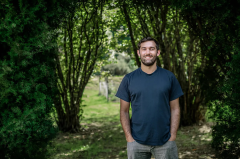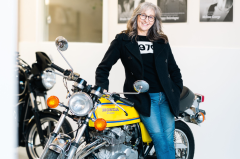From surfing in Mexico to leading sustainability at PwC, Camden Howitt went from ocean activist to global change-maker.
As the hot Mexican sun beat down on his shoulders, Camden Howitt paddled out on his surfboard towards the horizon. But his surf session resulted in a nasty surprise — not an epic wipeout, but a used nappy to the face.
“Times like that you sort of go, ‘We’ve got to do a lot better for nature and for ourselves. This impacts us.”
The year was 2005 and the then 21-year-old Howitt was on a study trip to Mexico. It was an experience that ignited Howitt’s passion for protecting and regenerating our oceans and waterways. A couple years after returning to his home in Aotearoa, New Zealand, Howitt co-founded Sustainable Coastlines, a not-for-profit organisation that delivers large-scale coastal clean-ups, education programs and litter data collection activities around New Zealand.
To date, the Sustainable Coastlines team has removed a hefty 1.8 million litres of litter from New Zealand coastlines, planted more than 330,000 trees to help prevent pollution runoff into waterways and provided ocean-action and environmental education for over 250,000 attendees from schools and businesses.
Since starting his sustainability journey, Howitt, now 41 years old, has become a leading voice in both the national and global conversation on marine pollution and environmental protection. He has addressed the United Nations three times on a global stage, twice at its headquarters in New York and again at the United Nations Environment Assembly in Nairobi, Kenya.
Curious to see what other ways he could provoke meaningful change for the planet, Howitt departed from Sustainable Coastlines in 2022. He’s now engaged in a senior role in PwC’s Sustainability, Climate and Nature team, leading a program that encourages some of New Zealand’s biggest and most influential companies to integrate nature and the environment into their decision making.
Howitt’s eff orts have also earned him New Zealand’s 2023 Environmental Hero of the Year award, a category of the New Zealander of the Year Awards.
Moana memories
The seedling of Howitt’s love for nature was planted in childhood. Raised in Christchurch on the South Island, Howitt recalls happy memories of holidays in the great outdoors with his parents and three siblings.
Both his parents were teachers, and most school holidays involved a trip immersed in nature. “Every Easter, we would go camping or hiking in the bush around rivers, lakes, forest, somewhere in Te Waipounamu, the South Island of New Zealand … and then we’d spend basically four to six weeks every summer at this beach, Ōpito Bay, in the Coromandel.”
Despite having now travelled the world to far-flung places, Howitt still describes being by the ocean in Opito Bay as his favourite place. “I think that as New Zealanders and South Pacific Islanders, we’re so connected to the ocean,” says Howitt. “We get kaimoana [seafood] there, so it feeds us. It’s a place where I have a lot of family memories … It’s also a place where I’ve seen the environment both at its best and at its worst.”
Growing up, Howitt’s sisters were passionate about sustainable living. They would rescue discarded food from supermarket dumpsters and run environmental protests. While Howitt always loved nature, he didn’t fully connect with environmentalism or initially share his sisters’ passion for it until the trip to Mexico changed his perspective and, in turn, his career and life trajectory.
Plastic predicament
While studying for two degrees, one in design for technology and the other in Spanish at the University of Otago, Howitt spent a year in Mexico as part of his studies. It was here that the unfortunate surfi ng experience unfolded. Witnessing a place of stunning natural beauty being polluted opened his eyes to the issue.
“I think it was spending a lot of time there, particularly along the beaches on the [Mexican] West Coast, and seeing a lot of pollution,” recalls Howitt. “Not just plastics and waste but runoff and other issues that just meant you could not enjoy being at the beach, and I think that was a real moment for me.”
Upon arriving home, Howitt started to realise that — just like the beach he’d visited in Mexico — his home country might not be as green and clean as some perceive it to be.
Research suggests that Howitt’s concerns are valid. According to data from the Organisation for Economic Co-operation and Development (OECD), New Zealand is regularly one of the worst offenders for waste production per person out of all OECD countries. According to a report by the New Zealand Infrastructure Commission, New Zealand has one of the lowest rates in the world for recycling — only 35 per cent of waste is recycled or reused. The rest goes to landfills, where it can end up in waterways and pollute the natural environment.
On the other side of the Tasman Sea, Australia has its own issues with water pollution. The Queen River in Tasmania is so polluted by mining runoff that its orange colour and sludgy appearance has earned it the nickname “pumpkin soup” by many locals. Further north, Forest Lake, an urban reservoir on the outskirts of Brisbane, has high levels of microplastics, according to a study published in the journal Nature in 2023. Researchers examined samples from 38 freshwater lakes from around the world and ranked Forest Lake as the sixth most contaminated of those tested.
Sustainable coastlines
After finishing his studies, Howitt started working at an advertising job in Auckland. Still inspired, he would push for environmental initiatives around the office. Howitt would encourage the team to recycle, championed sustainability policies and put his hand up to be assigned to projects with a sustainability theme.
Howitt’s friend, Sam Judd, was equally concerned by the issue of plastic pollution. Judd had been on the same trip to Mexico and had taken part in beach clean-ups on his own visit to the Galápagos Islands. Determined to find a solution to the problem, Howitt, Judd and their friend James Bailey co-founded and launched Sustainable Coastlines in 2009.
“We saw environmentalism, as it currently was, as something that was really difficult to engage with, because it was always negative, or always seemed negative to us,” says Howitt. “It was about protest and petition, blame and finger pointing, and what we wanted to do is switch that around and take a positive approach.”
The team focused on positive messaging through media, direct education and social media, highlighting wins and success stories, believing this would inspire people more than doom and negativity. “If you can talk about the future we want to see, not the future we don’t, then I think that can be really motivating for people,” says Howitt.
The charity’s first of many environmental events was a clean-up of Great Barrier Island, Aotea, an island located 90km northeast from Auckland. They brought together 700 volunteers for the beach clean-up from schools and the local community. More than 2.8 tonnes of litter was collected over two days, and the event garnered huge media attention.
The work that Sustainable Coastlines did in the early days is still having a big impact today. When Howitt recently revisited a site where





